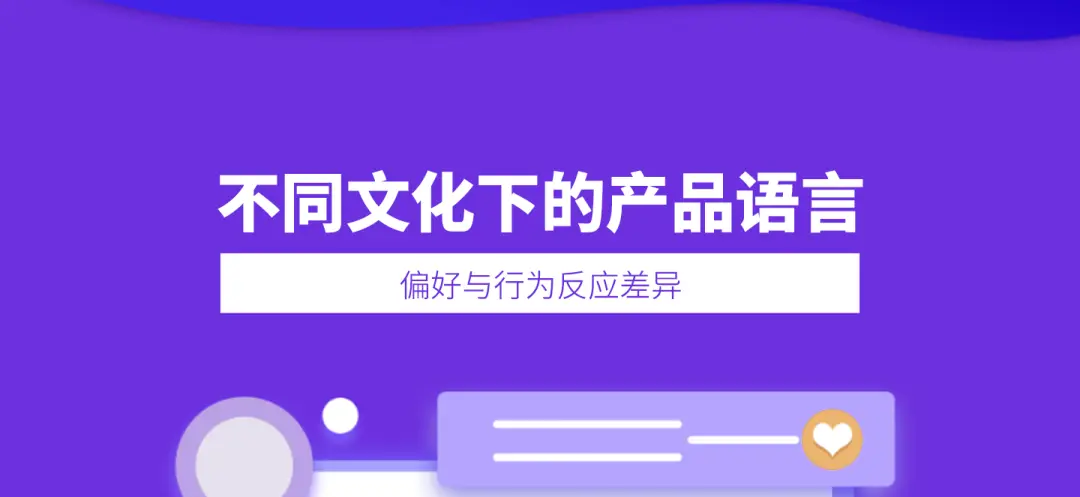Product Language Preferences and Behavioral Responses Across Cultures
In our interactions with clients at Giltbridge, we’ve observed a recurring pattern: a product that thrives in the domestic market, with its playful, vibrant, and personality-driven content, often receives glowing reviews. However, the same product, even when accurately translated, may fall flat in certain overseas markets. Users in these markets might describe the interface text as “too casual,” “l(fā)acking politeness,” or even perceive certain calls-to-action (CTAs) as “pressuring.”
Our takeaway is clear: language is never standalone. It is deeply rooted in cultural contexts. Users from different cultural backgrounds have distinct preferences for what makes product language feel comfortable and trustworthy, as well as how they interpret and respond to it. Ignoring these differences and applying a one-size-fits-all “standard language” globally can fracture user experience and lead to market failure.
Understanding the cultural logic behind user language behaviors is a critical step toward achieving truly effective global user experience (Global UX).
The Cultural Lens: How Language Is Decoded
Culture acts as an invisible lens, shaping values, communication styles, and social norms. These underlying structures directly influence how users perceive, interpret, and respond to language in products. We can use cross-cultural frameworks like cultural dimension theory and high/low-context theory to examine these differences:
- High-Context vs. Low-Context Cultures
- Low-Context Cultures (e.g., USA, Germany, Nordics): Communication is direct, clear, and explicit. Meaning is primarily conveyed through the words themselves, with a preference for straightforwardness.
- Language Preferences: Users favor unambiguous labels, detailed instructions, and direct CTAs or error messages, such as “Save Changes,” “Download Report,” or “Incorrect Password, Please Try Again.”
- Behavioral Response: Users expect information to be clear and actionable, enabling quick navigation and task completion. Vague or indirect expressions may feel confusing or inefficient.
- High-Context Cultures (e.g., Japan, China, Arab countries): Communication relies on shared knowledge, non-verbal cues, and implied meanings. Language tends to be indirect, polite, and context-sensitive.
- Language Preferences: Users prefer softer, courteous expressions and appropriate tone. Interfaces may rely more on icons or visual metaphors. CTAs are often gentler, like “Learn More” instead of “Buy Now.” Error messages may be phrased more tactfully, e.g., “It seems the entered information is incorrect; please review and try again.”
- Behavioral Response: Users focus on the overall tone and brand feel, and overly direct or “cold” language may create a sense of distance. They may spend more time interpreting implied meanings.
- Individualism vs. Collectivism
- Individualist Cultures (e.g., USA, Australia, Western Europe): Emphasis is on personal achievement, independence, and freedom of choice.
- Language Preferences: Language often highlights personal benefits, customized experiences, or efficiency, e.g., “Personalize Your Interface,” “Unleash Your Creativity,” or “Save Your Time.”
- Behavioral Response: Users are drawn to value propositions that cater to individual needs and self-expression.
- Collectivist Cultures (e.g., East Asia, Latin America, Middle East): Emphasis is on group harmony, belonging, and social responsibility.
- Language Preferences: Language focuses on social identity, collaboration, or community benefits, e.g., “Join Our Million-User Community,” “Share Results with Your Team,” or “Trusted by Industry Leaders.”
- Behavioral Response: Users are more influenced by social proof, group endorsements, or features benefiting the collective.
- High Power Distance Cultures (e.g., India, Brazil, Mexico, some Asian countries): Hierarchical relationships and authority are more accepted.
- Language Preferences: Users prefer formal, respectful tones and are more receptive to guidance from “systems” or “experts.”
- Behavioral Response: Users are inclined to follow clear instructions and may feel uncomfortable with overly casual or authority-challenging language.
- Low Power Distance Cultures (e.g., Nordics, Israel, Austria): Emphasis is on equality with less hierarchical sensitivity.
- Language Preferences: Users are comfortable with informal, egalitarian communication that encourages feedback, e.g., “Let’s Get Started Together!” or “What Do You Think?”
- Behavioral Response: Users prefer interactive, participatory experiences and expect a more equal relationship with the product.
- High Uncertainty Avoidance Cultures (e.g., Japan, Greece, Portugal, France): Preference for avoiding risk and ambiguity, seeking rules, stability, and reassurance.
- Language Preferences: Users value detailed explanations, clear rules, FAQs, safety certifications, expert endorsements, or refund guarantees to provide a sense of security.
- Behavioral Response: Users may need more information and reassurance before deciding and are cautious about actions with unclear outcomes.
- Low Uncertainty Avoidance Cultures (e.g., Singapore, Denmark, UK, Sweden): Greater tolerance for uncertainty and openness to new experiences.
- Language Preferences: Users accept concise instructions and exploratory interfaces and are open to new features or experiences.
- Behavioral Response: Users are more willing to experiment with unknown features and may find overly detailed rules or assurances unnecessary.
?
Language and Behavior in Practice: Case Studies
How do these cultural dimensions manifest in product language and user behavior?
- CTA Buttons: “Buy Now!” may perform well in low-context, individualist cultures but could feel aggressive in high-context, high uncertainty avoidance cultures, where “View Details” or “Add to Cart” may be safer and more effective.
- Error Messages: A blunt “Invalid Email Format” (low-context) versus a politer “Please Check if Your Email Address Is Correct” (high-context/high power distance). The latter, though longer, reduces frustration in certain cultures.
- Tutorials and Onboarding: Step-by-step detailed guides with visuals (high uncertainty avoidance) versus quick overviews highlighting key features (low uncertainty avoidance).
- Brand Tone: Slang, emojis, or playful language (low power distance/individualist) versus consistently professional, respectful tones (high power distance/collectivist).
A Real-World Example
Giltbridge assisted a company developing an online collaboration platform with its globalization efforts. In the North American market, their product used “Boost Your Team’s Synergy” as its core messaging, with a lively and direct tone. However, when entering Germany (low-context, moderate uncertainty avoidance, efficiency-focused) and Japan (high-context, high uncertainty avoidance, collectivist), we recommended adjustments:
- German Version: In collaboration with our German language experts, the copy emphasized “Enhance Project Efficiency,” “Clear Task Management,” and “Reliable Data Security.” The language was direct, precise, and supported by detailed feature descriptions and guides.
- Japanese Version: Working with Japanese localization consultants, the copy adopted a politer, more indirect tone, highlighting “Smooth Team Collaboration,” “Secure Information Sharing,” and “Widely Praised by Users.” We incorporated more visual elements and user success stories (social proof) with a humble, professional tone.
These culturally informed language adjustments helped the product avoid cultural mismatches and gain user trust and acceptance in both markets.
?
Addressing Cultural Differences in Language
To effectively navigate language differences in global products, we recommend:
- Conduct Cultural Research: Invest in understanding the target audience’s cultural background, communication preferences, and values before entering new markets.
- Adopt Flexible Design: Implement internationalization (i18n) to ensure the UI accommodates varying text lengths, formats (e.g., name order, date formats), and space for culturally specific content.
- Implement Targeted Localization: Go beyond translation with cultural adaptation (transcreation). This may involve creating distinct language versions for different markets rather than a single “standard translation.”
- Conduct Local User Testing: Engage real users in target markets to test localized versions, observing their behavior and gathering feedback on language naturalness, cultural appropriateness, and usability.
- Partner with Experts: Collaborate with language service providers (LSPs) with deep cross-cultural expertise and global resources.
?
Giltbridge: Your Cross-Cultural Language Navigator
Successfully navigating cultural differences in product language requires more than translation—it demands profound cultural insight and extensive localization expertise.
Giltbridge has nearly three decades of language service experience and a global network of experts, Giltbridge is your trusted partner in cross-cultural communication. We offer:
- Cultural Consulting and Insights: Our team includes not only language experts but also consultants familiar with specific market cultures, helping you analyze target users’ language preferences, behavioral patterns, and potential cultural pitfalls (e.g., differences in high/low-context or uncertainty avoidance).
- Culturally Adaptive Language Services: We provide transcreation and cultural adaptation beyond mere translation, ensuring your product’s UI copy, help documentation, and marketing materials are linguistically accurate and culturally resonant.
- Localized Testing and Validation: We organize user testing in target markets to validate language effectiveness and gather firsthand behavioral feedback, enabling continuous improvement.
About Giltbridge
With nearly three decades of growth, Giltbridge has remained dedicated to pursuing excellence—constantly refining our service quality and technical expertise to deliver outstanding language, content, and intellectual property solutions. We’re excited to partner with you on your journey to international success, unlocking opportunities and driving innovation along the way.
Contact Center
Whether you need our services or just want to learn more, reach out to our team via email, phone, or social media. We’re eager to work together and explore the boundless possibilities of the global market with you.






